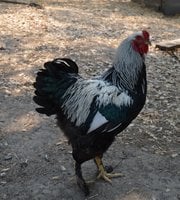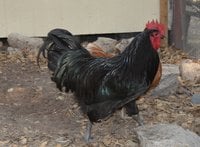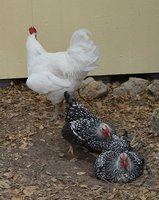Hi All
I have been keeping chickens for about a year, when we bought a little farm. We have Icelandic chickens, which are quite flighty and independent, but that is something I like about them.
At this time, I have about 40 birds -- 3 roosters and 16 hens that are 1.5-2 years old; the rest were hatched in April-June, so about 3-6 months old. I'm not quite sure how many of the new bunch are cockerels (it's dang hard to catch them all at the same time, these chooks like to WANDER and scatter themselves across 3 acres or so at any given time). I figure at least 8 are cockerels.
Despite having so many boys and around 1 males per 3 females, we have very few fights that I have observed (although I haven't spent time with them in the coop in a while, during the warm long days of summer we leave the coop door open at night, since they are in a tightly fenced orchard with the pigs so predation risk is low). Nevertheless, I don't think that this sex ratio is sustainable, and also I like chicken soup, so I am getting ready to cull about 10 from the flock, including a couple hens that hardly lay.
If I had some real "a**hole" roosters or cockerels it would be an easy choice of who to remove, but like I said, not much fighting observed. Does anyone have any suggestions on how to choose? Socially dominant ones? Ones that are always near hens (or never near hens)? Cull the shabbier looking older ones who have lost their tail feathers? I'm planning on leaving all cockerels and pullets that are not fully grown yet, and pulling less productive hens (including one that will NOT stop being broody, despite already hatching one batch this year). But aside from that I'm stumped -- just choose the least pretty ones?
I am going to spend some time in the next couple days more closely observing them (I've had my hands full with other farm tasks, including raising a puppy who wants to chase all the chickens, and haven't been spending the time I would like to observing them). But if anyone has any advice on how to choose among the roos, I'd like to hear it. Thanks!
I have been keeping chickens for about a year, when we bought a little farm. We have Icelandic chickens, which are quite flighty and independent, but that is something I like about them.
At this time, I have about 40 birds -- 3 roosters and 16 hens that are 1.5-2 years old; the rest were hatched in April-June, so about 3-6 months old. I'm not quite sure how many of the new bunch are cockerels (it's dang hard to catch them all at the same time, these chooks like to WANDER and scatter themselves across 3 acres or so at any given time). I figure at least 8 are cockerels.
Despite having so many boys and around 1 males per 3 females, we have very few fights that I have observed (although I haven't spent time with them in the coop in a while, during the warm long days of summer we leave the coop door open at night, since they are in a tightly fenced orchard with the pigs so predation risk is low). Nevertheless, I don't think that this sex ratio is sustainable, and also I like chicken soup, so I am getting ready to cull about 10 from the flock, including a couple hens that hardly lay.
If I had some real "a**hole" roosters or cockerels it would be an easy choice of who to remove, but like I said, not much fighting observed. Does anyone have any suggestions on how to choose? Socially dominant ones? Ones that are always near hens (or never near hens)? Cull the shabbier looking older ones who have lost their tail feathers? I'm planning on leaving all cockerels and pullets that are not fully grown yet, and pulling less productive hens (including one that will NOT stop being broody, despite already hatching one batch this year). But aside from that I'm stumped -- just choose the least pretty ones?
I am going to spend some time in the next couple days more closely observing them (I've had my hands full with other farm tasks, including raising a puppy who wants to chase all the chickens, and haven't been spending the time I would like to observing them). But if anyone has any advice on how to choose among the roos, I'd like to hear it. Thanks!












